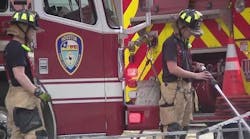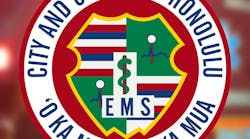Kentucky has developed an associate in applied science degree program in Fire/Rescue Science Technology that has a framework and components that we believe are exciting options for emergency responders or those seeking to prepare to be emergency responders.
Development and implementation of a quality educational program took several years of concentrated effort by many Kentucky stakeholders. In 1996, the director of Kentucky's State Fire Rescue Training Program, Steve Calhoun, brought together the 14 regional coordinators in the capital city of Frankfort to begin the process of developing a degree for our firefighters.
At that time, State Fire Rescue Training was housed within the state's post-secondary vocational school system. The program delivered quality, comprehensive classroom and hands-on training to 800-plus fire departments throughout the Commonwealth. Instruction ranged from the basic hoselays to the advanced levels of emergency medical care and hazardous materials response. Despite the quality of instruction, the classes were tied together only through a basic programmatic structure. Firefighters could participate for years, as thousands have, in quality educational programs delivered by State Fire Rescue Training, yet they received no credentials from an educational institution to verify the acquired knowledge and skills.
Our initial goal was to develop a program that would provide an educational credential for educational programming already occurring and to enhance future educational opportunities for the fire service of Kentucky. Most of the first two years were allocated to an analysis of what the successful individual should possess in knowledge and capabilities upon completion of the degree program.
We became convinced that the typical response of a fire service unit to an incident will have personnel arriving to find most emergency incidents falling into one of four categories: fire, EMS, rescue or hazardous materials. We believed our graduates should possess the knowledge and skills to begin assessment and incident stabilization in each of these four areas and the course objectives were constructed around this framework.
- Fire -- The program graduate meets Job Performance Requirements (JPRs) of National Fire Protection Association (NFPA) Firefighter I and II. The graduate is prepared to take Kentucky's International Fire Service Accreditation Congress (IFSAC) Accredited Firefighter I and II exams. In addition, the graduate will meet the requirements of the Kentucky Fire Commission for firefighter certification at the career level.
- EMS -- With the potential that the majority of fire departments will have more than 50% of their responses in emergency medical services, the graduate will be prepared at the EMT-Basic level. Standards used for this level of instruction include both the federal Department of Transportation EMT standard and the Kentucky Board of EMS Standard for EMT Certification. Instruction includes appropriate CPR and bloodborne pathogens certifications. The successful graduate will be prepared to take the National Registry of EMTs exam.
- Rescue -- When determining the curriculum for the rescue portion of the degree, we wanted the student to possess more knowledge than vehicle extrication. We wanted to be sure that students possessed technician-level rescue knowledge and skills in these areas: vehicle, farm, industrial machinery, confined space, structural, trench, high- and low-angle rescue, wilderness and water. We used multiple standards from several sources to develop this part of the program, but our guiding source today is NFPA 1670, Standard on Operations and Training for Technical Search and Rescue Incidents.
- Hazardous materials -- Before, during and after the creation of the Occupational Safety and Health Administration (OSHA) standard on hazardous materials (1910.120), the fire service has served as the first level of response in most areas of the nation to incidents involving hazardous materials. The program takes a student through the steps of meeting awareness, operations and ultimately technician levels of OSHA 1910.120. Beyond these four response areas, our desire was to create a responder who could think, analyze, communicate and lead, all within the concept of safety first. Basic courses in decision making, safety, company officer, incident management, communications and leadership prepare the graduate in these skills.
In 1997, the Kentucky General Assembly created the Kentucky Community and Technical College System (KCTCS). State Fire Rescue Training became a part of this new organization. Today, the KCTCS is comprised of 16 colleges on 65 campuses and is the largest provider of post-secondary education and workforce training in the Commonwealth.
Year three, 1998, was allocated to molding short- and long-term courses into a consistent and logical format focused on providing the student with the greatest opportunity of reaching the objectives of the program. Courses were developed in areas where curriculum did not exist or was insufficient.
The first true test came in 1999. Would the fire service endorse the program as proposed? By the end of the year, a consensus was built among the leadership of the Kentucky Community and Technical College System, State Fire Rescue Training Program, Kentucky Fire Commission, Kentucky Professional Firefighters Association and Kentucky Firefighters Association. The result was all stakeholders voting to endorse the program.
Year 2000 began with some outstanding educational experts within the KCTCS working to prepare a proposal meeting the degree submission, review and approval requirements of the KCTCS Board of Regents and Kentucky's Council on Postsecondary Education. In June 2000, KCTCS Chancellor Keith Bird submitted the proposal to the KCTCS Board of Regents. The leaders of Kentucky's major fire service organizations were present to assist with the presentation. By the end of the day, the newest degree within the KCTCS system was an associate in applied science (AAS) in Fire/Rescue Science Technology.
While this was occurring, the Kentucky General Assembly was consolidating the Kentucky Fire Commission and State Fire Rescue Training into one organization within the Kentucky Community and Technical College System. Statewide uniformity and a modular framework are significant features of the program.
-
Statewide uniformity -- The AAS Fire/Rescue Science Technology degree is offered through the community and technical colleges, all members of the KCTCS. The individual colleges are the degree-granting institutions.
The curriculum, tasks, objectives, syllabi, lesson plans, testing, grading process, instructor credentialing and approval ,and all other components of the degree are identical throughout Kentucky. We benefit from the ability to deliver the program in each of 14 fire service regions. This means that students have the capability of taking courses at multiple locations throughout Kentucky, graduates have their credentials recognized throughout Kentucky and employers know their abilities, no matter in which region of the state they live.
- Modular framework -- One of the outstanding features of the curriculum is the concept of "fractional credit" and "modular components." Developers believed that many individuals never began or completed a degree because of the structure of conventional college format courses and the time commitment. With the fractional credit system, students can begin the degree program and receive quick rewards for completion of small portions -- modules -- of a course. A typical college course is divided into modules with the credit fractionalized to reflect the instructional content. Module credits can be as little as one-tenth (0.1) of a credit hour. This was the first degree program within KCTCS to be approved using the modular framework.
- Student records -- The KCTCS student records-management computer software program, PeopleSoft, is an integral part of making the fractional-credit system operable. The KCTCS office staff was instrumental in implementing the fractional-credit tracking process in PeopleSoft. All student records throughout the system of 16 colleges are maintained within this one system. For the students attending courses at multiple locations in Kentucky, all records are within one transcript.
- Accreditation -- KCTCS, the Fire Commission and the State Fire Rescue Training Program are all strong believers in the accreditation process. Each of the community and technical colleges awarding the AAS in Fire/Rescue Science Technology are independently accredited though the Southern Association of Colleges and Schools (SACS) or the Council on Occupational Education. We participate, as do all of the programs, in this accreditation process. In addition to the institutional level accreditation provided by SACS, we desired an accreditation based on an intense review of our program. The International Fire Service Accreditation Congress (IFSAC) degree-accreditation process afforded the scrutiny we sought. As with all accreditations, the self-study process is as beneficial to the organization as the accreditation itself.
Implementation of the AAS Fire/Rescue Science Technology degree was phased in throughout the Commonwealth beginning in 2001. Courses are offered in fire departments and at regional fire schools throughout Kentucky and on many of our college campuses. Today, we have graduates of our program working in various emergency services professions and many more students in a variety of levels of completion.
Distance learning is an exciting opportunity for both educational institutions and students. Placing the AAS Fire/ Rescue Science Degree online through the KCTCS Virtual Learning Initiative is the newest phase of our development process.
Many events unfolded during our development process which greatly enhanced our capability. First was creation of the Kentucky Community and Technical College System. Second was the consolidation of the Kentucky Fire Commission and Kentucky State Fire Rescue Training into one organization attached to KCTCS. This placed the body responsible for establishing educational standards for Kentucky's fire service and the body responsible for delivery of educational programs to Kentucky's fire service into one structure.
The program is operating as we envisioned it 10 years ago. It provides the flexibility needed for the education of Kentucky's fire service. Its structure lets students participate in the degree program prior to or after joining a fire service organization. It has a curriculum that enhances the knowledge and skills of students, whether they are preparing to serve in the career, volunteer or allied fire service fields. Its framework permits full-time or part-time student enrollment status. Finally, students will soon be participating in online learning.
We are always interested in sharing what we have learned with other educational institutions. Ronnie Day is the executive director of the Kentucky Fire Commission. He and his staff are always receptive to requests for information. They may be contacted at 800-782-6823 or www.kctcs.edu/kyfirecommission.
BRYANT STILES has been with the Kentucky Fire Commission/State Fire Rescue Training for 17 years and is currently the State Fire Rescue Training Division Director. He is the Kentucky alternate director for the National Volunteer Fire Council. Stiles has been involved in the fire service since 1974, including five years as chief of the McLean County Central District Fire Department.





